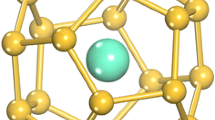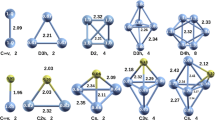Abstract
Two kinds of dimers consisting of two endohedral Eu@Si16 cages, Eu2@Si32 and Eu2@Si28, have been predicted by using density functional theory. The structural stabilities, electronic structures, and magnetic properties have been examined at the DFT-GGA level. The results show that each of the central Eu atoms in Eu2@Si32 and Eu2@Si28 keeps spin magnetic moment of about 6.9 μB, respectively. Analysis of electronic structures shows that sp2-like hybridizations induced by the central Eu atoms arise in Si-Si bonds, which remarkably improve the stabilities of both Si32 and Si28 clusters. Furthermore, two types of assembled Si nanotubes (Eu@SiNT-1 and Eu@SiNT-2) with Eu atoms encapsulated are gained; it is found that both of them are of metallic conductive character and have total magnetic moment of 14 μB. All these structures may be rather tempting for the future spintronic devices and high-density magnetic storage materials.

The electronic and magnetic properties of cluster-assembled Eu@SiNTs





Similar content being viewed by others
References
Sun Q, Wang Q, Briere TM, Kumar V, Kawazoe Y, Jena P (2002) First-principles calculations of metal stabilized Si20 cages. Phys Rev B 65:235417-1-5
Gao Y, Zeng XC (2005) M4@Si28 (M=Al,Ga): metal-encapsulated tetrahedral silicon fullerene. J Chem Phys 123:204325-1-4
Ngan VT, Janssens E, Claes P, Lyon JT, Fielicke A, Nguyen MT, Lievens P (2012) High magnetic moments in manganese-doped silicon clusters. Chem Eur J 18:15788–15793
Kumar V, Kawazoe Y (2001) Metal-encapsulated fullerenelike and cubic caged clusters of silicon. Phys Rev Lett 87:045503-1-4
He J, Wu K, Sa R, Li Q, Wei Y (2010) (Hyper)polarizabilities and optical absorption spectra of MSi12 clusters (M = Sc-Zn): a theoretical study. Chem Phys Lett 490:132–137
Felser C, Fecher GH (2013) Spintronics: from materials to devices. Springer, Berlin
Fang L, Bozdag KD, Chen CY, Truitt P, Epstein A, Johnston-Halperin E (2011) Electrical spin injection from an organic-based ferrimagnet in a hybrid organic-inorganic heterostructure. Phys Rev Lett 106:156602-1-4
Moodera JS, Santos TS, Nagahama T (2007) The phenomena of spin-filter tunneling. J Phys Condens Matter 19:165202-1-24
Grubisic A, Wang HP, Ko YJ, Bowena KH (2008) Photoelectron spectroscopy of europium-silicon cluster anions, EuSin − (3≤n≤17). J Chem Phys 129:054302
Kumar V, Singh AK, Kawazoe Y (2006) Charged and magnetic fullerenes of silicon by metal encapsulation: predictions from ab initio calculations. Phys Rev B 74:125411-1-5
Guo L, Zheng X, Zeng Z, Zhang C (2012) Spin orbital effect in lanthanides doped silicon cage clusters. Chem Phys Lett 550:134–137
Sun Q, Wang Q, Briere TM, Kawazoe Y (2002) Dimer interactions of magic W@Si12 clusters. J Phys Condens Matter 14:4503–4508
Wu X, Zhou S, Huang XM, Chen MD, King RB, Zhao JJ (2018) Revisit of large-gap Si16 clusters encapsulating group-IV metal atoms (Ti, Zr, Hf). J Comput Chem 39:2268–2272
Lu J, Nagase S (2003) Structural and electronic properties of metal-encapsulated silicon clusters in a large size range. Phys Rev Lett 90:115506-1-4
Reveles JU, Khanna SN (2006) Electronic counting rules for the stability of metal-silicon clusters. Phys Rev B 74:035435-1-6
Torres MB, Fernández EM, Balbás LC (2007) Theoretical study of isoelectronic SinM clusters (M=Sc−, Ti, V+, n=14-18). Phys Rev B 75:205425-1-12
Peng Q, Shen J, Chen NX (2008) Geometry and electronic stability of tungsten encapsulated silicon nanotubes. J Chem Phys 129:034704-1-9
Wang J, Ma QM, Xie Z, Liu Y, Li YC (2007) From SinNi to Ni@Sin: an investigation of configurations and electronic structure. Phys Rev B 76:035406-1-8
Ji WX, Luo CL (2010) Density functional investigation of hexagonal prism transition metal encapsulated cage M2Si18 (M=Sc-Zn) clusters. Model Simul Mater Sci Eng 18:025011-1-9
Sporea C, Rabilloud F, Aubert-Frécon M (2007) Charge transfers in mixed silicon-alkali clusters and dipole moments. THEOCHEM J Mol Struct 802:85–90
Wei S, Barnett RN, Landman U (1997) Energetics and structures of neutral and charged Sin (n ≤ 10) and sodium-doped Si n Na clusters. Phys Rev B 55:7935–7944
Singh AK, Kumar V, Brieve TM, Kawazoe Y (2002) Cluster assembled metal encapsulated thin nanotubes of silicon. Nano Lett 2:1243–1248
Zhan SC, Li BX, Yang JS (2007) Study of aluminum-doped silicon clusters. Physica B 387:421–429
Kumar V, Kawazoe Y (2003) Hydrogenated silicon fullerenes: effects of H on the stability of metal-encapsulated silicon clusters. Phys Rev Lett 90:055502-1-4
Belomoin G, Therrien J, Smith A, Rao S, Twesten R, Chaieb S, Nayfeh MH, Wagner L, Mitas L (2002) Observation of a magic discrete family of ultrabright Si nanoparticles. Appl Phys Lett 80:841–843
Jungnickel G, Frauenheim T, Jackson KA (2000) Structure and energetics of SinNm clusters: growth pathways in a heterogenous cluster system. J Chem Phys 112:1295–1305
Majumder C, Kulshreshtha SK (2004) Impurity-doped Si10 cluster: understanding the structural and electronic properties from first-principles calculations. Phys Rev B 70:245426-1-7
Huda MN, Ray AK (2004) Carbon dimer in silicon cage: a class of highly stable silicon carbide clusters. Phys Rev A 69:011201(R)-1-4
Hiura H, Miyazaki T, Kanayama T (2001) Formation of metal-encapsulating Si cage clusters. Phys Rev Lett 86:1733–1736
Wang J, Ma QM, Xu RP, Liu Y, Li YC (2009) 3d transition metals: which is the ideal guest for Sin (n=15, 16) cages. Phys Lett A 373:2869–2875
Khanna SN, Rao BK, Jena P (2002) Magic numbers in metalloinorganic clusters: chromium encapsulated in silicon cages. Phys Rev Lett 89:016803-1-4
Dognon JP, Clavaguéra C, Pyykkö P (2012) A new, centered 32-electron system: the predicted [U@Si20]6−-like isoelectronic series. Chem Sci 3:2843–2848
Peng Q, Shen J (2008) Growth behavior of La@Sin (n=1-21) metal-encapsulated clusters. J Chem Phys 128:084711-1-11
Wang J, Liu JH (2008) Investigation of size-selective Zr2@Sin (n=16-24) caged clusters. J Phys Chem A 112:4562–4567
Wang J, Liu JH (2008) Novel bi-transition metallic encapsulated naphthalene-like Si20 prismatic cage: a DFT investigation. J Comput Chem 30:1103–1110
Koyasu K, Akutsu M, Mitsui M, Nakajima A (2005) Selective formation of MSi16 (M = Sc, Ti, and V). J Am Chem Soc 127:4998–4999
Beck SM (1989) Mixed metal-silicon clusters formed by chemical reaction in a supersonic molecular beam: implications for reactions at the metal/silicon interface. J Chem Phys 90:6306–6312
Beck SM (1987) Studies of silicon cluster–metal atom compound formation in a supersonic molecular beam. J Chem Phys 87:4233–4234
Tsunoyama H, Akatsuka H, Shibuta M, Iwasa T, Mizuhata Y, Tokitoh N, Nakajima A (2017) Development of integrated dry-wet synthesis method for metal encapsulating silicon cage superatoms of M@Si16 (M=Ti and Ta). J Phys Chem C 121:20507–20516
Kumar V (2006) Alchemy at the nanoscale: magic heteroatom clusters and assemblies. Comput Mater Sci 36:1–11
Pham HT, Dang TM, Duong LV, Tamab NM, Nguyen MT (2018) B3@Si12 +: strong stabilizing effects of a triatomic cyclic boron unit on tubular silicon clusters. Phys Chem Chem Phys 20:7588–7592
Singh AK, Briere TM, Kumar V, Kawazoe Y (2003) Magnetism in transition-metal-doped silicon nanotubes. Phys Rev Lett 91:146802-1-4
Antonis NA, Giannis M, George EF, Madhu M (2002) Stabilization of Si-based cage clusters and nanotubes by encapsulation of transition metal atoms. New J Phys 4:78-1-14
Ma L, Zhao JJ, Wang JG, Wang BL, Lu QL, Wang GH (2006) Growth behavior and magnetic properties of SinFe (n=2-14) clusters. Phys Rev B 73:125439-1-8
Wang J, Zhao J, Ma L, Wang G, King RB (2007) Stability and magnetic properties of Fe encapsulating in silicon nanotubes. Nanotechnology 18:235705-1-8
Xu HG, Kong XY, Deng XJ, Zhang ZG, Zheng WJ (2014) Smallest fullerene-like silicon cage stabilized by a V2 unit. J Chem Phys 140:024308
Wang J, Liu Y, Li YC (2010) Magnetic silicon fullerene. Phys Chem Chem Phys 12:11428–11431
Guo LJ, Zheng XH, Zeng Z (2011) Transition metal encapsulated hydrogenated silicon nanotubes: silicon-based half-metal. Phys Lett A 375:4209–4213
Iijima S (1991) Helical microtubules of graphitic carbon. Nature 354:56–58
Delley B (2000) From molecules to solids with the DMol3 approach. J Chem Phys 113:7756–7764
Perdew JP, Wang Y (1992) Accurate and simple analytic representation of the electron-gas correlation energy. Phys Rev B 45:13244–13249
Delley B (1990) An all-electron numerical method for solving the local density functional for polyatomic molecules. J Chem Phys 92:508–517
Delley B (2002) Hardness conserving semilocal pseudopotentials. Phys Rev B 66:155125-1-9
Acknowledgments
We would like to thank Dr. Qing-Fang Cheng for his help with the language.
Funding
This work is financially supported by the Natural Science Foundation of Hebei Province for Distinguished Young Scholar (Grant No. A2018205174).
Author information
Authors and Affiliations
Corresponding author
Additional information
Publisher’s note
Springer Nature remains neutral with regard to jurisdictional claims in published maps and institutional affiliations.
Rights and permissions
About this article
Cite this article
Chen, Z., Xie, Z. First-principles investigation on cluster-assembled silicon nanotubes with Eu atoms encapsulation. J Mol Model 25, 226 (2019). https://doi.org/10.1007/s00894-019-4122-4
Received:
Accepted:
Published:
DOI: https://doi.org/10.1007/s00894-019-4122-4




